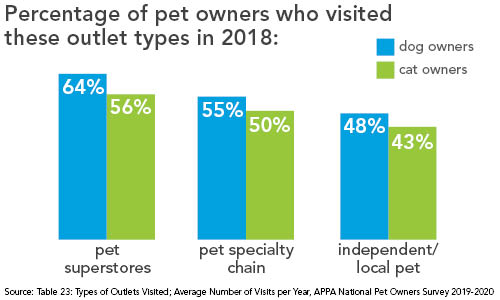ORLANDO, Fla. — Pet industry spending reached a new all-time high in 2018, totaling $72.56 billion, according to the 2019-2020 National Pet Owners Survey conducted annually by the American Pet Products Association (APPA). Last year, pet owners spent 4%, or $3 billion, more on pet care supplies and services compared to 2017.
“Millennials continue to be the largest pet-owning demographic and this shows in the data,” said Bob Vetere, president and CEO of APPA, who announced the key findings from the survey during Global Pet Expo on March 21. “We know this generation is willing to pay more for quality products and services to improve the health and well-being of their pets. Today more than ever, pet owners view their pets as irreplaceable members of their families and lives, and it’s thanks to this that we continue to see such incredible growth within the pet care community.”
A breakdown of the spending data shows pet owners spent an estimated $30.32 billion on pet food in 2018, an increase of 4.3% from 2017. APPA went on to predict spending on pet food would increase by 4.5% over the next year, estimating spending to reach $31.68 billion by the end of 2019.
According to the study, premium pet foods are purchased most frequently in the US market, followed by generic and natural pet foods. APPA’s 2018 survey indicated 68% of US households owned a pet and the 2019 survey reports that number is now 67%. A plateauing rate of pet ownership in the US paired with a static volume of pet food sales indicates growing spending in this category is the result of increased pricing and the amplified number of sales of premium pet food with high-quality ingredients.
“In the coming year, we anticipate steady growth in the pet food category thanks to opportunities that reside in specialized diets, targeting the aging pet population and pets with unique dietary needs,” Vetere said. “The availability of fresh food options and subscription delivery programs is also expected to increase spending in this category.”
The survey also indicated that in the overall pet industry, including sales and behaviors in the veterinary care, supplies/over-the-counter medications, live animal purchases and other services markets, pet owners predominantly visited pet superstores to purchase products and services over independent or pet specialty stores and pet retail chains, such as PetSmart or Petco.
Additionally, slightly more than 50% of dog and cat owners made at least one online purchase for their pet in 2018, with an average of about five online purchases per pet owner.
The average amount pet-owning households spent on pet food in 2018 totaled $259 for dog owners and $228 for cat owners. Average spending on treats came to $76 for dog owners and $58 for cat owners, and dog owners spent an average of $51 on chews. More than 90% of dog owners and 86% of cat owners reported buying treats for their pet in 2018, according to the survey.
The latest Pet Owners Survey was conducted using updated methodologies to create a more nationally representative sample of pet ownership in the US and reflect both the research objectives and overall pet market, according to APPA.
“We are proud of our latest study, as it’s nationally representative and features a broad range of data that goes far beyond consumer purchasing behaviors,” Vetere said. “With such a large pool of respondents, the margin of error is extremely low, providing us with the most accurate and detailed report of pet ownership in the US on record.”
APPA conducts this annual survey of pet owners to provide a snapshot of pet ownership, categorical spending and give context to the modern pet industry in the US. The executive summary of the survey will be available on the APPA website in Spring 2019.
“For 30 years, APPA’s National Pet Owners Survey has been one of the foremost providers of consumer insight research in the pet market,” Vetere said. “I look forward to seeing how members of the pet care community use these new findings to improve our pets’ quality of life.”
Keep up with the latest pet food trends on our Trends page.




